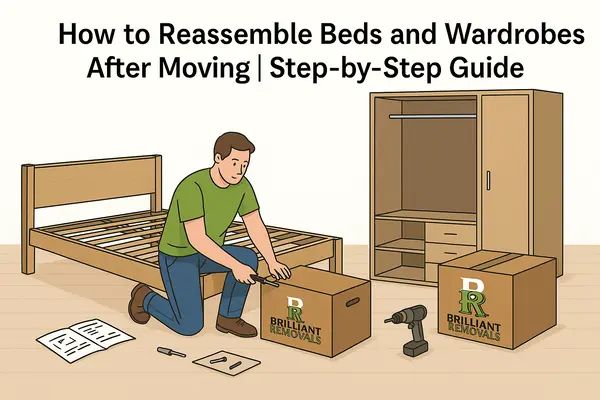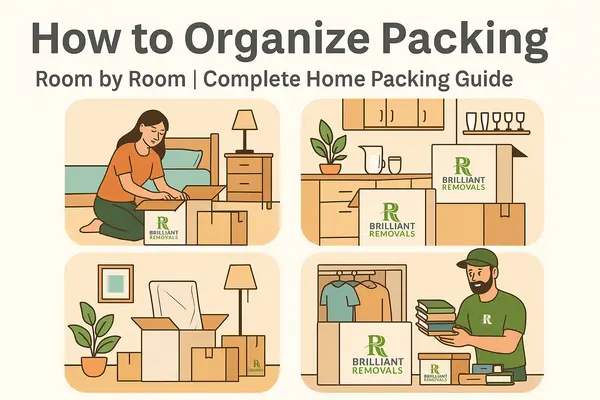
How to Pack Clothes Efficiently for a Move
Packing clothes can quickly become one of the most time-consuming parts of moving. Between your daily wear, seasonal garments, and special outfits, you may be surprised by how much space they take up. Learning how to pack clothes efficiently for a move not only saves space but also ensures your clothing arrives clean, wrinkle-free, and easy to unpack.
This guide will help you plan, organise, and execute your clothing packing process with professional techniques — just like expert movers in London do.
Why Packing Clothes Smartly Matters
Clothes may not seem fragile, but improper packing can lead to:
- Wrinkling and creasing
- Unnecessary bulk in boxes
- Difficult unpacking
- Potential mildew or dust damage (especially during long-distance moves)
Packing efficiently saves both time and money — fewer boxes mean reduced van space and shorter loading times.
Sorting and Decluttering: The First Step
Before even touching a box, declutter your wardrobe. Moving is the best time to part with clothes you no longer wear.
How to Declutter Efficiently
| Category | Action |
| Worn-out clothes | Recycle or discard |
| Clothes that no longer fit | Donate or sell |
| Seasonal clothes you won’t need soon | Pack separately |
| Sentimental clothing | Store in a separate “keep forever” box |
Tip:
Use the “1-year rule”: If you haven’t worn it in a year, it’s probably safe to let it go.
Choose the Right Packing Supplies
Packing clothes efficiently starts with the right tools. Here’s what you’ll need:
Essential Supplies
- Wardrobe boxes – Ideal for hanging clothes; keeps them wrinkle-free.
- Medium boxes or suitcases – Great for folded clothes.
- Vacuum-sealed bags – Save up to 70% of space for bulky items.
- Garment bags – Protect formalwear and delicate fabrics.
- Plastic wrap or bin liners – Quick DIY protection for hanging clothes.
- Packing tape and markers – For sealing and labelling boxes.
Relevant Articles:
How to Pack Fragile Items Safely for Transport
Categorise Your Clothing
Organise your clothes into groups before packing. This makes unpacking in your new home simple and efficient.
Suggested Grouping
- Everyday clothes
- Seasonal wear (winter/summer)
- Formalwear and delicate fabrics
- Shoes and accessories
- Laundry or clothes to be washed
Label each category clearly. You can even assign a box colour or number to each type.
Folding vs Rolling: Which is Better?
Both methods have their place, depending on the type of clothing.
| Type of Clothing | Best Method | Reason |
| T-shirts, jeans, shorts | Rolling | Saves space and prevents wrinkles |
| Dress shirts, blouses | Folding | Keeps shape intact |
| Sweaters, hoodies | Folding | Prevents stretching |
| Underwear, socks | Rolling | Compact and easy to fit |
| Formalwear | Hanging | Avoids creases completely |
Pro Tip:
Try the Marie Kondo fold for shirts — it stands upright in boxes, making it easy to unpack and organise later.
How to Pack Different Types of Clothing
Each type of clothing requires slightly different care. Here’s how to do it right:
A. Hanging Clothes
- Keep them on hangers and use wardrobe boxes.
- For a cheaper option, wrap a plastic bin liner over groups of hangers.
- Secure the hanger tops with rubber bands to prevent tangling.
B. Folded Clothes
- Use medium boxes lined with tissue paper or plastic.
- Pack heavier items (like jeans) at the bottom.
- Place lighter fabrics (like t-shirts) on top.
C. Bulky Items
- Store in vacuum-sealed bags to save space.
- Ideal for jackets, blankets, or winter coats.
D. Shoes and Accessories
- Store belts, hats, and scarves in small boxes or fabric bags.
- Wrap shoes in packing paper to prevent scuffs.
- Place socks inside shoes to save space.
Use Suitcases and Drawers Smartly
You don’t have to pack everything in boxes — use what you already have.
- Suitcases: Perfect for heavy items like jeans and sweaters.
- Drawers: Wrap entire drawers in plastic wrap to move them as they are.
- Baskets or hampers: Great for soft items like towels or bedding.
This strategy reduces the number of boxes you’ll need and speeds up the unpacking process.
Label Everything Clearly
Labelling is crucial for a stress-free unpacking experience.
Label Example
- “Bedroom 1 – Hanging Clothes”
- “Bedroom 2 – Winter Wear (Vacuum-Sealed)”
- “Shoes – Fragile Items Inside”
Include details like room, category, and handling notes on each box.
Tip: Use waterproof markers and label on multiple sides of the box.
Relevant Articles:
How to Label Boxes for an Easy Unpacking Process
How to Label and Store Screws and Parts for Reassembly | Moving Made Easy
Packing Timeline for Clothes
| Timeline | What to Pack |
| 3–4 weeks before move | Off-season clothes, formalwear |
| 2 weeks before | Casual wear, shoes, accessories |
| 1 week before | Most of your wardrobe except essentials |
| 2–3 days before | Outfits for the final days |
| Moving day | Clothes in “essentials bag” only |
Your essentials bag should include:
- 2–3 days of clothing
- Pajamas
- Toiletries
- Work/school clothes
- Medications and undergarments
Keep Clothes Fresh During the Move
Here are ways to ensure your clothes don’t pick up odours or moisture:
- Place a dryer sheet or lavender sachet in each box.
- Use breathable fabric bags for delicates.
- Avoid packing damp clothes — they can cause mildew.
- Keep boxes in a dry, cool area until moving day.
Tips for Long-Distance Moves
If you’re moving long-distance or to another city like London, take extra precautions:
- Use airtight containers for long-term freshness.
- Keep delicate items in garment bags.
- Avoid overstuffing boxes (it damages clothes).
- Consider professional packing services if you have expensive garments.
Professional movers such as Brilliant Removals offer wardrobe packing, eco-friendly materials, and door-to-door clothing transport, ideal for cross-city or student relocations.
Relevant Articles:
Choose the Best Transport Option for Long-Distance Moving
How to Track Your Belongings During a Long-Distance Move
Eco-Friendly Clothing Packing Tips
Going green while moving is easier than you think:
- Avoid plastic where possible — choose cloth garment bags.
- Reuse cardboard boxes or borrow from friends.
- Use old linens, towels, or pillowcases instead of bubble wrap.
- Donate unwanted clothes to local charities.
Common Mistakes to Avoid When Packing Clothes
| Mistake | Problem Caused | Solution |
| Overpacking boxes | Boxes tear or collapse | Use medium-sized boxes |
| Ignoring labelling | Confusing unpacking | Label all sides clearly |
| Packing dirty clothes | Musty smell | Wash before packing |
| Using large boxes for heavy items | Risk of injury | Distribute weight evenly |
Consider Professional Packing Help
If packing clothes isn’t your strong suit, hire professionals who can handle it for you.
Brilliant Removals London offers:
- Full or partial clothing packing
- Wardrobe box rental
- Garment care and labeling service
- Eco-friendly wrapping options
You’ll save hours of work and ensure your clothes arrive fresh and ready to wear.
Summary
Packing clothes efficiently doesn’t have to be a stressful task. With the right planning, supplies, and strategy, you’ll make the process smooth and manageable.
Remember to pack early, label clearly, and use all available space — including suitcases and drawers.
If you want a hassle-free experience, Brilliant Removals’ packing and moving services ensure your clothes arrive fresh, organised, and wrinkle-free — whether you’re moving across London or to a new city.











